


2023-2024
Bulk Water Supply
Weed Biosecurity
Flood Mitigation






2023-2024
Bulk Water Supply
Weed Biosecurity
Flood Mitigation


Rous County Council acknowledges the Traditional Custodians of the land upon which we work and live. We pay our respects to the Elders of the past, present and emerging and acknowledge their continuing connection to Country who will guide us on our shared journey to the future.
See our Statement of Commitment 2023
Level 4, 218-232 Molesworth Street, Lismore NSW 2480
PO Box 230, Lismore NSW 2480
8.30am to 4.30pm Monday to Friday, excluding public holidays
(02) 6623 3800
council@rous.nsw.gov.au
www.rous.nsw.gov.au



Disclaimer and copyright
@RousCountyCouncil
www.linkedin.com/company/rous-county-council
@rouscountycouncil
The information contained in this report, including opinions, advice and representations (the Content) has been formulated in good faith and with all due care and is considered true and correct at the time of publication. Rous County Council does not warrant or represent that the Content is free from errors or omissions or that it is exhaustive. Rous does not accept any liability in relation to the quality or accuracy of the Content.
Rous, its respective servants and agents, accept no responsibility for any person acting on, or relying on, or upon the Content. To the extent permitted by law, Rous disclaims all liability for any loss, damage, cost or expense incurred or arising by reason of any person using or relying on the Content or by reason or by any error, omission, defect or misstatement (whether such error, omission or misstatement is caused by or arises from negligence, lack of care or otherwise). Users of this Annual Report are reminded of the need to ensure that all information upon which they rely is up to date. Clarification regarding the currency of the Content can be obtained from Rous.
You are permitted to copy, distribute, display and otherwise freely deal with the Content for any purpose, on the condition that you acknowledge Rous County Council as the source of the Content and attach the following statement to all uses of the Content ‘© Rous County Council’. If you are seeking to use any Content for a commercial purpose, you must obtain permission from Rous.
© Rous County Council 2024.

This Annual Report summarises the activities and performance of Rous for 2023-2024 against our Delivery Program and Operational Plan. As well as reporting on our activities, the report contains a range of statutory reporting information. This and earlier annual reports are available on our website: www.rous.nsw.gov.au

A
message
Cr Robert Mustow Rous Chair
It has been my utmost pleasure to have served our Northern Rivers community as Chair of Rous County Council (Rous) during the 2023/24 reporting year.
As this term draws to a close, marking the end to the threeyear tenure, it makes me proud to look back and recognise the successes we have achieved together while facing a series of unprecedented challenges.
In 2021, we continued to experience lockdowns, border closures, and waves of COVID-19. The following year, our region was devastated by the biggest flood in modern Australian history. In 2023, we came close to initiating water restrictions ahead of the 2023/24 summer.
While quickly pivoting and prioritising throughout these extraordinary events, staff at Rous continued to deliver multiyear capital projects, face new and existing weed biosecurity incursions, manage a network of more than 700 individual floodgates, provide high quality drinking water to more than 110,000 people, all while ensuring the Northern Rivers has a secure water supply that will meet the community’s needs to 2060 and beyond.
The dedication of Rous staff did not waver despite many facing their own personal hardships. When met with adversity, our community demonstrates our remarkable resilience and strength.
Some accomplishments include - but are not limited to – the adoption of the Integrated Water Cycle Management Strategy as part of the Future Water Project 2060 and the opening of the $27 million St Helena Pipeline allowing for more water to flow to coastal areas within the network.
Rous’ achievements have been acknowledged. The Water Operations team were recognised for their perseverance during the 2022 floods and were awarded the Team of the Year Award at the Water Industry Operators Association of Australia Reconnect Day. In 2023, the Bush Regeneration Project at Fosters Spur received an Excellence in the Environment Award, Local Government, NSW. Also in 2023, Rous won the prestigious IXOM Best Tasting Tap Water competition for New South Wales and Australian Capital Territory.
The high level of service Rous provides for the community is testament to the close partnerships we have with our constituent councils, local businesses, stakeholders and partners, landholders, Traditional Custodians and residents.
I look forward to seeing what Rous can achieve in the next term for our community.


While we are still rebuilding, repairing and recovering from the aftermath of the catastrophic events we have faced over the past few years, Rous is looking ahead and planning for our future.
During the 2023/24 reporting period, we launched a suite of online platforms to help streamline our operational processes ahead of our relocation to Ballina.
Our Transformation and Strategy team has been thoroughly examining our existing digital infrastructure, with the goal of simplifying our activity by introducing integrated and userfriendly online systems. One of the first to be launched will be a new payroll system later in 2024.
We commenced the installation of digital smart meters for our direct water customers who also received a new My Rous app, which provides updates on personal water usage.
We introduced a new fraud detection and payment protection system to help mitigate the financial risks associated with cyber fraud.
Our new intranet site, Rous Hub, launched with an app allowing our staff, whether working in the office or in the field, to have access to the same information in one place.
Rous has been working with a consulting company on a new brand and website to help communicate who we are, what we do and why we do it. Both are set to be rolled-out in 2025.
Looking further ahead, Rous is on track to meet the 70 per cent emissions reduction by 2035 and 100 per cent by 2050 targets as part of the 2023 Renewable Energy and Emissions Reduction Plan.
As part of the Future Water Project 2060, two significant investigative projects have been completed: the Purified Recycled Water (PRW) Investigations Report and the Desalination Investigation Report.
While this year we have welcomed many exciting changes, with more to come, we recognise that our staff and our community have been through traumatic events in recent years.
In addition to the health, wellbeing and psychological safety initiatives led by the People and Culture team, we continued to provide Yarning Circles as an opportunity for Rous staff to support each other.
This year we have taken one step closer towards our strategic goals as service providers for the region while continuing to deliver the highest quality water, weed biosecurity and rural flood mitigation services for our community in the Northern Rivers.
I would like to thank our staff, our community and the constituent councils of Ballina, Byron, Lismore, Richmond Valley, and the councils we service on a fee-for-service arrangement, Kyogle and Tweed.

The elected council is made up of eight councillors with two nominated from each of the constituent councils (Ballina, Byron, Lismore and Richmond Valley). Councillors are elected for a four-year term with the chairperson and deputy chairperson being elected by the councillors. The chairperson and the deputy chairperson hold their positions for a two-year term.








To support and ensure the delivery of various key projects including relocation to new premises in Ballina and the implementation of new enterprise wide software, a temporary structure has been implemented until the end of 2025 calendar year.
Council
Council
General Manager
Planning
Organisational
Transformation
Audit






and Properties



To partner with our constituent councils to provide quality services that support a sustainable and productive region.
Thrive and evolve as a valued regional service provider.


There are currently nine county councils in New South Wales (NSW) whose functions are limited to the supply of bulk water, flood mitigation, or weed biosecurity services. Rous provides all three of these services and is currently the only multipurpose county council in NSW.
Rous provides bulk water to Lismore City, Richmond Valley, Ballina Shire and Byron Shire council areas.
Flood Mitigation services are provided by Rous within the Richmond River floodplain of Ballina Shire, Richmond Valley and Lismore council areas.
In addition to the above councils, Rous also provides Weed Biosecurity services under a fee-for-service arrangement to Tweed Shire and Kyogle councils.
Together, Lismore City Council, Ballina Shire Council, Byron Shire Council and Richmond Valley Council make up Rous’s constituent councils.

We provide water in bulk to local government areas of Ballina, Byron, Lismore and Richmond Valley –our principal water supply source is Rocky Creek Dam.
We are the regional water supply authority providing water in bulk to the local government areas of Lismore (excluding Nimbin), Ballina (excluding Wardell), Byron (excluding Mullumbimby) and Richmond Valley (excluding land to the west of Coraki).
A population of around 110,000 is serviced by this water supply system with the area of operations being approximately 3,000km2 The regional supply network includes around 49,000 connections within the reticulation areas of the local government areas it services and nearly 2,000 retail connections to our trunk main system.
Reticulation of the water within the urban centres is the responsibility of our member councils.
The principal source of our supply network is Rocky Creek Dam (RCD) situated 25km north of Lismore near the village of Dunoon. The dam has a storage capacity of 14,000 mega litres (ML). Other available sources under our control include Emigrant Creek Dam (ECD), Wilsons River Source (WRS) near Lismore, Converys Lane and Lumley Park bores in the Alstonville area, as well as bores in the Richmond Valley area.
Rous’water infrastructure is valued at more than $570 million. This includes the physical trunk main and pipeline system (which is 432 kilometres long), as well as reservoirs, RCD, ECD, WRS, two water treatment plants (Emigrant Creek and Habbie Habib Nightcap) and some areas made available to the public in and around RCD and ECD.

Exercising powers and duties in relation to weed biosecurity, identifying and managing high-risk weed species.
We focus on:
Exclude new weeds (prevent them establishing in our region).
Eradicate or contain any new priority weeds found in the region (eliminate them or stop their spread).
Effectively manage the impacts of widespread invasive weed species.
Build capacity in our region to help the community, industry and government commit to long-term management of invasive weeds.
• Identification and management of high-risk weed species and how they spread into and within our region.
• Improving our capacity to find new weeds early.
• Ensuring we have the resources and procedures to take rapid strategic control measures against new weeds in our region.
• Directing our resources to where benefits will be the greatest.
• Increasing community commitment and involvement in proactive weed management.
• We also deliver weed biosecurity services under a service level agreement to Kyogle and Tweed Shire councils.

We manage 80km of levees, 750 individual floodgates and 180km of drains, which work together to reduce inundation and divert floodwater.
Rous is the local Flood Mitigation Authority for the Lismore City, Richmond Valley and Ballina Shire local government areas; an area well known for its flooding. We have a proud history of mitigating the impact of floods on the community, dating back to 1959.
Our service delivery relates to maintenance of existing flood mitigation infrastructure and managing the natural resource impacts resulting from the operation of this infrastructure.
We manage 80km of levees, 750 individual floodgates and 190km of drains, which work together to reduce inundation and divert floodwater. This infrastructure is very important to the communities who live and work along the Richmond River. In addition, we also have a role in relation to a levee and related infrastructure designed to protect the central business district of Lismore against a 1 in 10-year flood.
While levees, floodgates and drains provide flood mitigation, unfortunately, over time this infrastructure may contribute to poor water quality and fish kills, altering wetlands and changing the natural environment. Rous is committed to continue working cooperatively with landowners to reduce this impact.
The Rocky Mouth Creek floodgates are an example of the infrastructure that Rous manages. Located near the village of Woodburn, these six large floodgates prevent floodwater from the Richmond River travelling up Rocky Mouth Creek and inundating low lying land.
Outside of flood times, these floodgates are kept winched open to allow tidal water to exchange between the river and the creek. This improves water quality and benefits aquatic life. Rous has an Active Floodgate Management Plan for Rocky Mouth Creek which is a voluntary agreement with the landowners on how the floodgates will be managed to reduce their environmental impact.
We also have a strong interest in activities such as hydrological research, flood surveying and modelling. This enables us to better understand flood behaviours and the impact of flooding on the catchment and floodplain.
As a flood mitigation authority, we also partner with our constituent councils to coordinate the preparation and submission of grant funding applications for agreed regional projects.



Rous’ activity is split into four organisational groups. They are Planning and Delivery, Organisational Services, Transformation and Strategy and Operations. Each group comprises of various teams that together meet Rous’ Delivery Program and Operational Plan objectives. The following section details operational highlights for the year from these teams.

During the reporting period, Rous in partnership with contractors, commenced installing new ‘digital smart water meters’ for the majority of its 2,132 direct water customers.
Historically, Rous has undertaken manual reading of customer water meters on a quarterly basis. While this is adequate for billing requirements, it provides little information for Rous and customers on actual water use and any leaks that might occur.
Smart meters are connected to existing digital communication networks and provide daily updates directly to a customer via the My Rous app. The app helps customers to be more aware of their water consumption. Customers can monitor their water use, explore ways to reduce their use, and identify any unusual activity that might indicate a leak.
Installation commenced in February 2024 in Ballina and was expected to be completed during July 2024.



The 2018 Greenhouse Abatement Strategy was updated during the reporting period to include the 2023 Renewable Energy and Emissions Reduction Plan, which outlines the program of works to meet the emissions reduction targets by 2050.
The future activities identified to reduce emissions include the installation of solar PV and battery energy storage systems (BESS) projects, transitioning to energy efficient fleet and outdoor equipment, the inclusion of emissions reduction infrastructure in all new capital projects, and continuing with the revegetation and tree planting initiatives.
• target zero emissions by 2050 (in line with State Government and Federal Government targets)
• target 70 per cent emissions reduction by 2035 compared to baseline period (2005-2017)
• seek to increase the proportion of renewable electricity where cost effective to do so.
By implementing these feasible projects, Rous is on track to meet the 70 per cent emissions reduction by 2035 and 100 per cent by 2050 targets.
In October 2023, the Planning and Delivery team completed the removal and replacement of biologically-activated carbon (BAC) from the two BAC filtration tanks located at the Emigrant Creek Water Treatment Plant.
These tanks function as two large charcoal water filters, capable of filtering approximately 100 litres of water per second.
Biologically active carbon filtration is an effective process for eliminating synthetic organic chemicals and pesticides and the process can also reduce the concentrations of taste and odourcausing compounds such as short-chain aldehydes (fruity), amines and aliphatic aldehydes (fishy), and phenols and chlorinated phenols (antiseptic/medicinal).
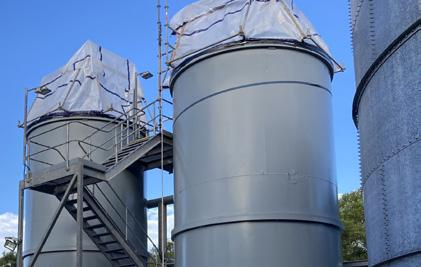
The project involved many elements including removal of approximately 120 cubic metres of spent BAC media using a vacuum excavator.
Permission was also sought and granted from the NSW Environment Protection Authority to divert the spent media from landfill and re-use it in potting mix. The spent BAC media was then supplied to a local garden supply retailer, thereby saving Council approximately $15,000 in waste disposal fees and converted a waste product into a valuable resource.
Throughout the project, strict environmental controls were put in place to ensure no fumes, dust or particles be emitted into the environment and no contaminants were introduced.

Rous has been active in taking responsibility for dam safety for many years and has been progressively implementing the Dam Safety Management system as per the Dams Safety NSW Regulation 2019.
In the reporting period, Rous developed and updated the multi-year projects including the Dam Safety Strategic Plans, Dam Break and Consequence Category Assessments, Emergency Plans, and Operational Plans.
Of particular interest was the investigations focused on the seismicity, geology and geotechnical aspects of the Emigrant Creek Dam wall. The report primarily considered the impact of earthquakes, big and small, on the dams. Geotechnical investigations also formed part of the report, resulting in the use of sonic drilling rigs, core drilling rigs, and cone penetration testing rigs at the Emigrant Creek Dam wall to test for shear strength, permeability and unit weight, Atterberg limits, and density.
During the 2023/24 reporting period Rous has developed Dam Safety Reports and Comprehensive Risk Reports for both the Emigrant Creek Dam and the Rocky Creek Dam, which are due for completion in 2025.



The Future Water Project 2060 (FWP2060) represents Rous’ Integrated Water Cycle Management strategy and is its planning process to ensure the Northern Rivers has a secure and resilient water supply now and into the future. It sets out a three-stage approach that includes more water saving initiatives (see Demand Management section on page 20) and the delivery of new supply sources. During the reporting period, a suite of factsheets, FAQs and a project update were developed to support the community’s understanding of project activities.
Progress continues to be made on the Alstonville Plateau Water Supply Scheme. The scheme includes the proposed new Alstonville Plateau Water Treatment Plant that will treat water from the Clarence Moreton Basin (CMB) sub-aquifer, the Alstonville Plateau basalt aquifer and surface water from Marom Creek. Rous has successfully secured a temporary allocation water licence for longterm testing of the CMB. Verifying relatively new water sources such as the CMB are an important step in ensuring that water is safe to drink and sustainable to extract.
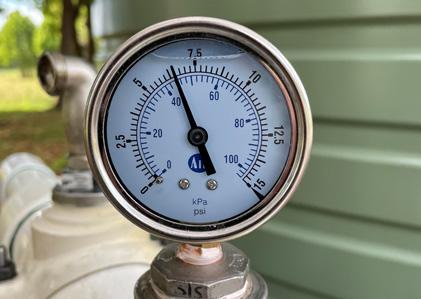
At Woodburn, since securing flood recovery funding from the NSW Government in the previous reporting year, a lead contractor was appointed and a scope of works to repair and replace infrastructure was approved. Historic bores were decommissioned, while new bore testing and ecological assessments continued. Rous also acquired a parcel of land at Woodburn that will ensure access to a productive area of the bore field and connectivity to the proposed new water treatment plant. A draft design and treatment process of the plant was prepared in the reporting period and an options assessment for the most prospective location commenced.
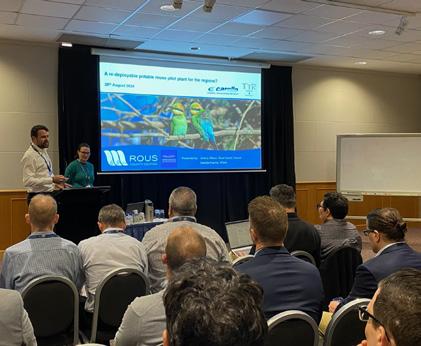
Rous staff presenting at the 2024 Australian Water Association’s (AWA) state conference.
The FWP2060 achieved a considerable milestone in the reporting period with the completion of two significant investigative projects: the Purified Recycled Water (PRW) Investigations Report and the Desalination Investigation Report. Both multi-year investigations have increased Rous’ understanding of manufactured water, acknowledging its ability to provide rainfall independent sources to diversify the supply system as well as presenting the constraints in their potential implementation in the Northern Rivers.
These reports provide critical, contemporary information to inform the comparison of all long-term water sources, including surface water and groundwater, which are still being investigated. Rous continues to explore and test new groundwater sources that could meet the community’s future water needs and has also commenced work on the Cultural Heritage and Biodiversity Assessments for a potential new surface water option west of Dunoon.
Council, Byron Shire Council and Ballina Shire Council regions proactively took steps to improve their water efficiency and reduce the demand on the region’s water supplies.
Through Rous’ Sustainable Water Partner Pilot Program, the local businesses and schools were provided with bespoke advice relating to their current water usage and an action plan on how they can make changes to reduce their consumption of drinking water.
Rous sponsored the onsite audits with water efficiency consultants from The Water Conservancy, who examined how water is used and detailed opportunities to maximise savings.

Conservancy.
This involved comparing water use against similar businesses and identifying any system deficiencies, including leaks.
The Sustainable Water Partner Pilot Program builds on the success of work undertaken previously, which included businesses using more than five megalitres of water per annum.
The Sustainable Water Partner Pilot Program is part of the Rous Regional Demand Management Plan 2023-2026.
Rous’ Regional Water Education Officer broadened the reach of the water sustainability education program by presenting at thirteen local businesses and schools, environmental organisations and libraries. During the reporting period, the program reached approximately 2,200 students.
The Australian curriculum was mapped to determine areas of overlap with Rous’ key water sustainability messages and to guide the development of further educational opportunities.
Presentations were met with enthusiasm, generating positive feedback and requests for future involvement. Complementary to this, a marketing campaign, utilising local media, social media, and community partnerships, significantly boosted participation in Water Night 2023.
Aspects of program development focused on mapping the NSW Education Curriculum with Rous water conservation messages and goals to identify target areas of delivery for the regional water education program.

As part of Rous’ work in the Wilsons River catchment, in March 2024 600 trees were provided for a community planting day at Eltham. This allowed for a larger revegetation area to be completed than what was originally planned.
Previously, the site was almost completely covered with woody weeds, including camphor laurels and privets. Extensive weeds have been removed allowing for native vegetation to be planted. This will benefit native fish, stabilise riparian banks and help reduce erosion.
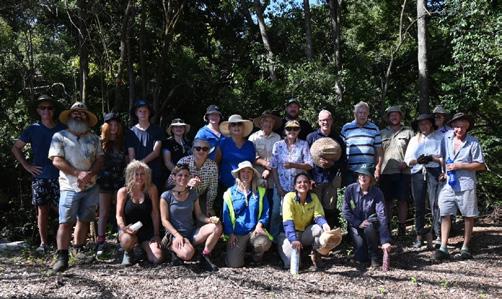

More than two kilometres of degraded riverbank along the Richmond River is being regenerated as part of the multi-year Coraki Riparian Project. The Coraki Riparian Project is a contribution from Rous towards riparian restoration as identified in the Richmond River Coastal Zone Management Plan 2011.
Led by Rous, this project has seen more than 2000 trees planted, tonnes of rubbish removed, and habitats improved.
Funding for the first phase of this project at Windsor Park and other sites in Coraki town was provided by Department of Regional NSW – Primary Industries Recreational Fishing Trust’s ‘Habitat Action Grant Program’ and matched with financial contributions from Rous.
In addition to improving conditions for fish species, koalas in this region are under real threat from lack of habitat and weed vines limiting their access to the trees. By removing waste and weeds, and re-introducing native tree species, Rous is aiming to support a healthy riparian zone along the riverbank and koala habitats on the drier areas.
Continued over page ...


Phase 1 of the project exceeded regeneration targets. A similar project on the East Coraki side of the river begun in November of 2023 with funding from a Coast and Estuaries Management Grant provided by NSW Department of Climate Change, Energy, the Environment and Water, and matched with $40,000 from Rous.
Approximately one kilometre of riparian land at East Coraki will be regenerated, with the site currently in very poor condition and in danger of losing the remainder of its canopy trees to weed vines.
Rous has partnered with Richmond Valley Council, Bogal Local Aboriginal Land Council and Bandjalang Aboriginal Corporation on this project.



In implementing Rous’ Reconciliation Action Plan (RAP), consistent feedback from the Reconciliation Action Plan Advisory group has been to focus RAP efforts on supporting existing community efforts rather than ‘reinventing the wheel.’
Richmond Riverkeeper, in partnership with Southern Cross University, has established an ongoing citizen science project to assess and map river health across the Richmond River catchment.
The project reports ecological river health, water quality, and riparian condition collected by the community across the catchment and has been facilitated by a river health assessment specialist who has been effectively volunteering his time to train the community in the sampling of freshwater ecology (macroinvertebrates).

Through the RAP, Rous has been able to support this initiative that has allowed greater involvement of ranger programs within from local First Nations organisations.
Both Jali and Ngulingah Local Aboriginal Land Councils (LALCs) have a Ranger program that operates on lands owned by them including Indigenous Protected Areas (IPA). Rous’ Reconciliation Liaison Officer has been able to encourage and facilitate the involvement of the LALC Rangers in the water monitoring training provided by the specialist and has provided the required equipment for the LALC’s to undertake their own water monitoring activities on Country. This program is now being extended to other First Nations organisations working on Country.



On 1 October 2023, the new Public Interest Disclosure Act 2022 (PID Act) – also known as the whistleblower protection legislation - came into effect.
Under the new PID Act, there is a ‘no wrong door’ approach to the reporting of suspected wrongdoing (for example corruption, financial conflicts of interest, destruction of evidence and or records (unauthorised), serious waste and or misuse of Rous resources.). To achieve this, the PID Act now requires all supervisors to be trained to receive reports of suspected wrongdoing and all permanently maintained Rous worksites to have a designated disclosure officer for the same purpose.
An online training module was assigned to all supervisors and worksite disclosure officers in ELMO to provide awareness and education of roles and responsibilities in receiving reports of suspected wrongdoing and promoting a ‘speak up’ culture at Rous.
A new electronic form was developed for use by all staff when considering reporting suspected wrongdoing.
During the 2023/24 reporting period, Rous reviewed and updated its internal procedures for managing feedback, complaints, and unreasonable conduct to support Rous staff apply the principles of procedural fairness and the following key policy commitments consistently when interacting with customers, the community, and other stakeholders:
1. Respectful treatment
2. Information and accessibility
3. Good communication
4. Taking ownership
5. Timeliness
6. Transparency
This review included establishing reporting practices that will help Rous to identify service delivery areas for review and improvement to ensure acceptable levels of service are continued to be provided to Rous customers, community, and stakeholders.
The new online feedback and complaints form, available on the ‘contact us’ page of the website (rous.nsw.gov.au/contact-us), will also make communicating with Rous easier and ensure customer feedback is managed by the most appropriate officer at Rous.
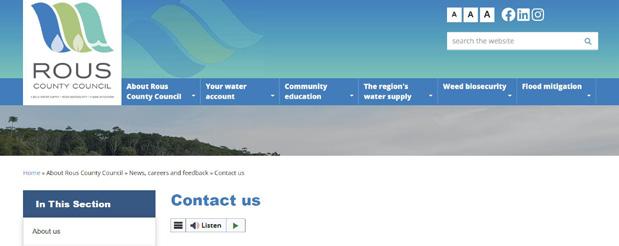
'Contact Us' using Rous' website.
The People and Culture team continued to enhance and modernise human resources practices, with a focus on refining recruitment and onboarding processes.
These improvements were designed to support the new talent marketing strategy and drive greater consistency and transparency.
The new talent marketing strategy has been developed in collaboration with a specialist agency to attract top talent to Rous.
During the reporting period, the People and Culture team continued to make significant strides in their commitment to health, wellbeing, and psychological safety.
The leadership team engaged in a Healthy Workplace Audit to assess Rous’ wellbeing readiness and maturity. This helped the team to better understand the role of wellbeing in the business plan and how they can actively support it with the involvement of employees and wellbeing partners.
The purpose of Rous’ wellbeing strategy is to:
• Manage risks - particularly to change
• Improve employee engagement – empower employees to take proactive involvement in the change process
• Adopt best practice - understand the current wellbeing landscape, consult employees, identify risks, plan, act, review
• Strengthen environmental, social and governance
• Manage an aging workforce
• Ultimately be known as an employer of choice (EOC)
By investing in the above, Rous hopes to demonstrate the care that staff have for one-another with the intention of working towards becoming a safe and supportive workplace.
The long-term goal is for all employees to take an active role in managing their own wellbeing and supporting the wellbeing of others. This will involve shifting from a reactive approach to a proactive one, helping everyone understand their role in the wellness strategy.
The goals are (in order of importance):
• Achieve compliance and do the right thing for the business and its people
• Support a thriving workplace and grow employee engagement - particularly in times of change
• Prevent ill-health, reduce workers’ compensation claims, reduce absenteeism, and therefore improve productivity
• Attract and retain good staff and strengthen our reputation
The intention is to have an action plan developed and active in 2024/25.
During the reporting period, the Customer and Communications team continued to implement the Communications and Engagement Strategy, which aims to increase the visibility and recognition of Rous by strengthening its brand. Here is a summary of some of the activities that were delivered by the team for Rous.
Rous communications were centralised within the Customer and Communications team to create a more cohesive message, for both internal and external audiences.
Rous’ social media reach and engagement increased during the reporting period, with its Facebook page reaching more than 219,300 accounts and receiving more than 8,500 content interactions. In comparison with the previous reporting period, 2022/23, with more than 149,300 accounts reached and 3,600 content interactions.
This includes the Miconia campaign, which was arranged by the Customer and Communications team, in partnership with the Weed Biosecurity team and outsourced with an external specialist agency. Through this campaign, more than 90,000 accounts were reached on social media (cumulative).
Media training was arranged for senior staff to help strengthen Rous’ capability when sharing important milestones and urgent notifications. During the reporting period, Rous staff were interviewed by journalists in the region and featured on ABC North Coast, The Echo, Northern Rivers Times, ZZZ FM, Paradise FM, NBN Northern Rivers News, 7NEWS North Coast, and more.
The team also assumed responsibility of internal events and hosted a series of all-staff meetings, including International Women’s Day. A new interactive format for all-staff meetings was introduced by the team to increase engagement.
To help streamline internal processes, a content calendar was arranged for staff across the organisation to populate to ensure key messages were consistent and important information was shared amongst teams. The use of digital forms increased, and an image library was created with access also provided to staff through the Rous Hub.
The branding and marketing strategy was completed, with the new brand and website set to launch early in the 2025 calendar year. As part of this process, Rous’ current communication methods, website, and social media channels were examined, and various staff were interviewed for their recommendations.
Rous is rebranding to ensure that its visual identity and messaging align more closely with the mission, vision, and values. This change will help Rous present a cohesive and accurate reflection of who Rous are, what Rous do and why Rous do it.

In June 2024, Rous launched its new intranet - Rous Hub.
Prior to Rous Hub, staff were required to access important information and documents from a range of sources.
Since its launch, staff are provided with a convenient, accessible, online location that holds various resources, documents, and policies.
Rous Hub also updates staff on project milestones, news, upcoming events and is a space to celebrate achievements.
Rous Hub has been rolled out on smart devices through an app, ensuring both outdoor and indoor staff are kept up to date and have the same information in one place.
In June 2024, Phase 1 was launched. As part of Phase 2, Rous plans to expand the capability of Rous Hub.



Rous has a comprehensive program of inspections and pre-starts to provide a safe and environmentally sustainable workplace. These procedures are crucial for identifying potential hazards, ensuring compliance with relevant regulations and fostering a safe and compliant work environment for employees.
Throughout the reporting period, inspections were conducted consistently, ensuring that all areas of operations were thoroughly monitored. By identifying and addressing potential hazards early, Rous can effectively prevent accidents and equipment failures, resulting in reduced downtime and associated costs.
During the 2023/24 reporting period, Rous competed 4144 inspections and pre-starts - an increase from 2021/22 with 194 inspections and 2022/23 with 3126. The increase underscores Rous’ dedication to safety and environmental protection.

During October 2023, the Health, Safety, Environment and Logistics team hosted weekly morning teas, called ‘Safe-T’, conducted across the business as part of National Safe Work Month. Rous’ Leadership Team co-hosted the Safe-T events, in partnership with the Health, Safety, Environment and Logistics team. The primary objective was to encourage all staff to prioritise safety and work towards reducing the number of work-related injuries, illnesses and fatalities.
The topics for each week were:
• Week 1 (1-8 October) – Working together to manage risks at work
• Week 2 (9-15 October) – Working together to protect workers’ mental health
• Week 3 (16-22 October) – Working together to support all workers
• Week 4 (23-31 October) – Working together to ensure a safe and healthy workplace.
Also in 2023, the team held a reptile awareness program for staff. The program was provided due to the varying locations Rous’ staff work, including outdoors, and their chance of an encounter with reptiles.
Through the program, staff received information about how to react and retreat if they see reptiles (particularly snakes), environmental factors that may increase the likelihood of exposure, and how to apply first aid if needed.


Sustainable Procurement Framework embedded
The Sustainable Procurement Framework was successfully embedded into Rous’ policies and procedures, ensuring that sustainability is a core consideration in all purchasing decisions.
A Supplier Code of Conduct was developed and implemented to foster stronger relationships with suppliers committed to sustainable practices. Additionally, comprehensive training programs were conducted to equip Rous staff with the knowledge and skills necessary to assess and implement sustainable procurement initiatives.
To track progress and evaluate outcomes, robust performance indicators have been established. These indicators allow for regular monitoring and evaluation of Rous’ achievements in sustainable procurement.

In May 2023, an internal review of our stores and inventory management practices was successfully completed by our dedicated staff. This initiative was undertaken in the context of a previous internal audit concerning the Procure to Pay process and followed the early mobilisation of Rous’ Gallans Road site in response to recent flooding. The review aimed to assess operational effectiveness and identify areas for improvement, focusing on critical spares management, reporting gaps, and providing valuable insights to inform the Gallans Road site plan, particularly regarding safety in design.
In response to the findings from this review, a temporary team is being established to facilitate the implementation of the recommended outcomes. This team will operate for up to two years. The team will be positioned under the oversight of the Health Safety Environment and Logistics Manager, reporting to the Group Manager of Organisational Services, to ensure alignment with Rous’ organisational objectives.
The newly formed team will consist of existing staff members, including, the Fleet and Properties Officer, Stores and Depot Officer, Procurement Advisor and HSE Officer. It is important to note that there will be reporting line changes for the duration of the team’s operation, ensuring clarity and accountability within the structure.
The temporary team is set to commenced operations mid-September 2023. The key responsibilities are across several critical operational areas, including Health, Safety, Environment (HSE), logistics, stores management, fleet operations, procurement, and contract management. Additionally, they will oversee property maintenance.
The establishment of this team reflects our commitment to enhancing operational efficiency and responsiveness within Rous’ stores and inventory management practices. By addressing the key findings from the internal review, we anticipate significant improvements in resource management and compliance with safety standards, ultimately benefiting Rous’ organisational performance and stakeholder engagement.


Finance developed a Business Performance Pack which has been utilised throughout the reporting period.
The pack contains important financial information and data from several other departments across the organisation including Major Projects, Health Safety Environment and Logistics, Water Operations, Weed Biosecurity and Bush Regeneration, Flood Mitigation, ICT, People and Culture, Customer and Communications, Governance and Risk, and Procurement.
Monthly meetings have been implemented to review the data with the Leadership Team. This process enhances Rous’ financial management and creates visibility across other areas of the organisation.
Additionally, during the reporting period a fraud detection and payment protection system, EftSure, was introduced.
The system utilises aggregated banking data from six million Australian companies (approximately 80 per cent of active businesses) to verify banking details in real time.
The process reduces the risk of human error and mitigates the financial risks associated with cyber fraud.
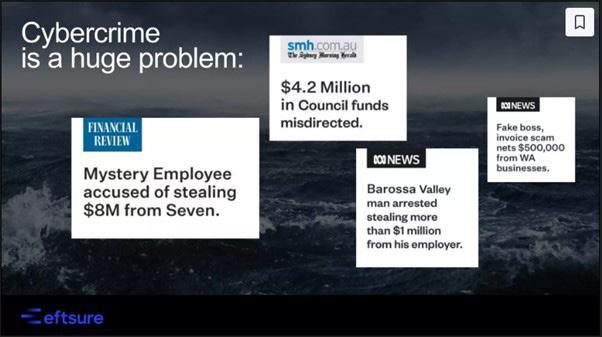
Finance staff are responsible for managing Council’s finances and the day-to-day processes involve many transactions. Below are the key statistics from the 2023/24 financial year compared to the previous year.
The antennas at Parrot’s Nest were replaced and relocated during the 2023/24 reporting period.
The antennas were approaching ‘end of life’ and due to be replaced. Additionally, the tower they were located on had two major issues: the signal to Nightcap Water Treatment Plant was impacted due to trees on a private property obscuring the direct line-of-sight; and there was not a generator or other form of back-up power to rely on during emergencies.
The Information and Communications Technology (ICT) team worked alongside another provider to relocate the equipment to a tower that is better suited and is expected to provide increased resilience during emergency events.
In January 2024, the WiFi replacement project was successfully completed. This project has resolved the intermittent reliability issues staff were experiencing in meeting rooms and while roaming.
The project team also improved the WiFi reception at Rous’ Nightcap Water Treatment Plant. As part of the project, additional access points were installed to provide coverage throughout the entire plant - with the assistance of Rous’ electricians. This has improved the Dams and Treatment staff’s ability to complete work in the field.
The ICT Team successfully simplified the user experience in meeting rooms located at various Rous sites.
The meeting rooms in the Molesworth Street office were replaced with new equipment that is easier for staff to use and consistent across all meeting rooms.
Additionally, the same meeting audio visual systems were installed at Woodburn Depot and Nightcap Water Treatment Plant. These remote locations now have suitable meeting room setups, allowing staff to host and attend online meetings effectively and efficiently.



In 2023, Rous launched Project Novus, its comprehensive digital transformation program designed to replace legacy business applications with integrated digital technologies and adopt improved, simplified business processes across the organisation.
This initiative took a significant step forward in April 2024 with the formation of the Transformation and Strategy team, which combines the Change and Innovation team with additional resources to drive these critical changes. Alongside these project team resources, a dedicated People and Change team was established to modernise Rous’ people agenda, integrate new work practices, and ensure a smooth transition for its workforce.
The first phase of Rous transformation involves implementing a new payroll system that features an Employee Self-Service (ESS) portal. This portal will enable staff to manage their timesheets, access payslips, and submit leave requests more efficiently. Rous is currently finalising system configuration and conducting initial testing, with plans to roll out the new system in the second quarter of 2024.
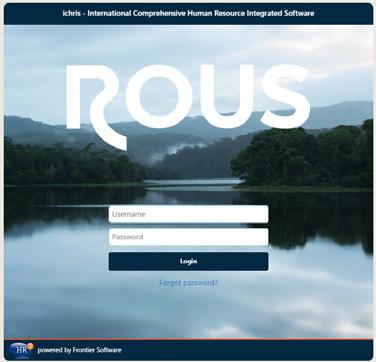
system.
Phase 2: New Enterprise Resource Planning (ERP), Enterprise Asset Management (EAM) and Customer Relationship Management (CRM) systems
The second phase of Project Novus continues to advance Rous digital transformation agenda. Following the completion of the vendor selection process in late FY2023/24, Rous is set to kick off the Novus Blueprint phase in July 2024. This phase will focus on developing detailed designs for new systems. Implementation will take place over FY2024/25 and FY2025/26.


Perradenya Estate is a residential housing development situated in the Caniaba area, close to the City of Lismore.
It has been designed as an ecologically sustainable development, which upon completion will consist of up to 160 residential dwellings, a small commercial centre and open green space.
Rous has been progressing the development since 2002 and is currently undertaking a strategic review of outstanding development conditions to inform the investment of resources to finalise the estate.
In October 2021, Rous resolved to purchase 57 Gallans Road, Ballina, NSW.
The property will provide an integrated administration and works depot complex, Council chambers and public meeting space with exciting opportunities for enhanced community engagement. Construction will also include an upgraded car park and new hardstand storage area.
This project is a key element to effective alignment, integration, and cultural change for a collocated Rous workforce.



Rous staff have been working with various town planning, architectural and building consultants to finalise plans with construction expected to commence in 2024 and be completed by the end of 2025.
During the reporting period, initial steps were taken to temporarily relocate staff to alternative work locations to make way for construction activities.
During the reporting period, the flood mitigation team achieved the significant milestone of repairing all infrastructure damaged in the catastrophic 2022 floods - in addition to completing routine maintenance, several large capital works and heavy maintenance projects.
The repair of Tuckombil and Bungawalbyn Levees brought both back to their pre-flood condition, and concluded the team’s recovery from the 2022 floods and heralded the return of business as usual. Additional funds, provided under the Natural Disaster Relief Assistance Program and State and Commonwealth Government’s Disaster Recovery Funding Arrangements, allowed Rous to repair erosion and a slump on Tuckombil Levee and to reinstate rock armouring that had slumped on Bunagwalbyn levee (led by Rous’ Planning and Delivery team).
Rous has responsibility for a network of more than 700 individual floodgates. These floodgates play an important role in allowing land to drain after floods and heavy rain, while preventing tidal water from inundating land. After years of service, the lifting beam and gears that operate the Rocky Mouth Creek floodgates near Woodburn were refurbished as part of Rous’ flood mitigation capital works program. The six very large floodgates prevent floodwater from the Richmond River travelling up Rocky Mouth Creek and inundating low lying land. The lifting beam and gears are used almost constantly to allow for active floodgate management, which allows for tidal water to exchange between the river and the creek (outside of floods) improving its environmental condition of the waterway and benefits aquatic life. The lifting beam and gears are also used to allow maintenance to occur and remove debris from the floodgates.
As part of Rous’ capital renewal program, old and rusted gates are replaced with new aluminium floodgates, skilfully manufactured in-house. Rous is one of the only councils in the region that manufactures their own floodgates, which provides a significant cost saving when maintaining a very large network. During the reporting period, 18 replacement floodgates were both manufactured and installed within the Rous network, with the floodgates ranging in size from 1800 millimetre to 600 millimetre in diameter.

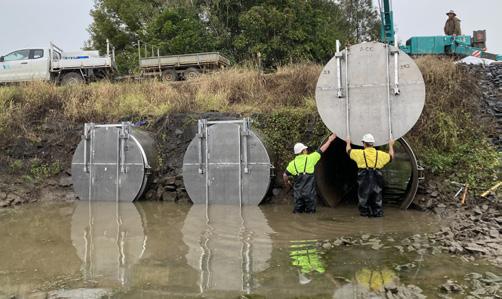


Constant and regular maintenance is required to keep the Rous network of flood mitigation infrastructure in working order. Rous’ Flood Mitigation Operators carry out routine maintenance on a daily and weekly basis. These maintenance activities include checking floodgates to ensure they are free of debris and operating normally; removing debris from floodgates; using herbicides to control aquatic vegetation in drains and canals; and maintaining access to infrastructure by slashing. During the reporting period the team carried out a staggering 2,100 inspections of floodgates, treated 38 kilometres of drains with herbicide and slashed more than 250 kilometres along levees and drains.
Heavy maintenance was undertaken along a two kilometre stretch of Stibbards Drain in the Green Forest-East Coraki area. The flood mitigation team mechanically removed vegetation and silt deposited during the 2022 floods and repaired a 100-metre-long drain bank slip. Apart from servicing agriculture properties and rural residential dwellings, the drainage system also drains water away from Wyrallah Road, the main transport route between Woodburn and Lismore. Further heavy maintenance occurred to Bungawalbyn Levee where woody vegetation was removed from a kilometre of the levee.



At the start of 2024, Rous launched a public awareness campaign to help protect rainforests in the Northern Rivers region from Miconia (Miconia calvescens) - a highly invasive weed species that can cause devastating environmental damage if not reported in time.
Miconia quickly forms monocultures by shading out its competitors. It has caused widespread damage to rainforests internationally and is growing in the northern parts of Australia.
Through this campaign, more than 90,000 people were reached on social media (cumulative), and nearly 2,500 clicked to the website – at 3.07 per cent this is above the industry average of 1.5 per cent. Traffic to the Miconia webpage significantly increased by 8,391 per cent during the campaign period (compared with the six-month period prior).
As a direct result of the television commercial, a Miconia plant was identified at a property in Lennox Head.
A local resident had been growing the single Miconia plant as a garden ornamental, unaware of its invasive tendencies. At the time of inspection, it was flowering and starting to develop fruit.
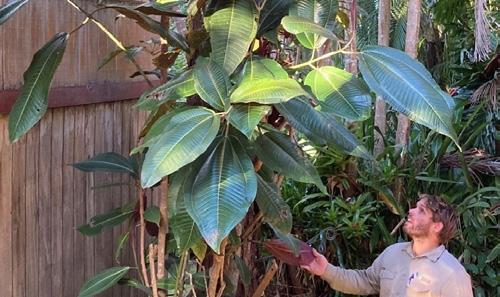
Rous Biosecurity officers then visited the property and confirmed the plant to be Miconia calvescens. They removed and destroyed the fruit, and the plant was destroyed and a mailout sent to the surrounding neighbourhood with properties inspected.
Since 2003, almost 200 seedlings and plants have been collected locally by Weed Biosecurity Officers. It continues to be a serious environmental (and economic) risk.

As the Local Control Authority, Rous has certain legislative responsibilities to manage weeds in accordance with the Biosecurity Act (2015), accompanying regulations and regional plans. According to these regulations, Rous’ role is to specifically manage “priority weeds”.
During the 2023/24 reporting period, Rous’ Weed Biosecurity Team completed 9015 inspections and facilitated the control of 4121 hectares of state and regional priority weed sites.
To help control more common weeds in the region, community members are encouraged to perform management techniques on their properties.
In January 2024, the Weed Biosecurity team produced a series of weed control videos which were posted on Rous social media channels. The production of these videos demonstrated the Weed Biosecurity team’s commitment to providing accessible educational material for landholders in the Northern Rivers region to safely and effectively manage weeds on their properties.
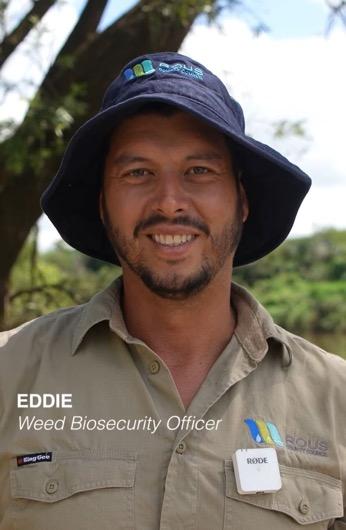
Officers from the Weed Biosecurity team demonstrated a number of primary weed control techniques. These included: cut and paint, foliar spray, stem inject, basal bark, and manual removal techniques. The videos also provided a brief overview as to which weeds in the Northern Rivers region the techniques applied to.
Rous sponsored the weed control videos on its social media channels to reach a large audience within the local region. The five videos in total reached more than 66,000 accounts and overall, the community response to the videos was favourable. The Weed Biosecurity team’s intention is to maintain community awareness regarding weed control by regularly reposting the videos and encouraging landholders to contact Rous with any weed control enquiries.


In 2023, Rous won the prestigious IXOM Best Tasting Tap Water competition for New South Wales and Australian Capital Territory.
Rous was among the top three finalists selected from a long list of competing water providers at the annual Water Industry Operators Association of Australia (WIOA) conference held in Canberra.
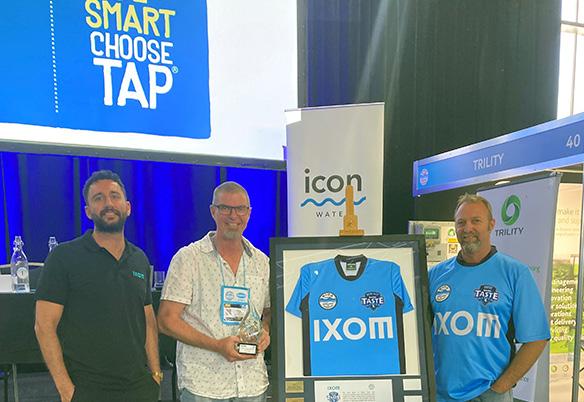
Rous won IXOM Best Tasting Tap Water at the Water Industry Operators Association of Australian conference.
The IXOM Best Tasting Tap Water Award is strongly contested, and it is a source of immense pride for water operators who are dedicated to delivering high-quality water to their communities.
The judging process involved blind taste tests, evaluating aspects like colour, clarity, odour, and mouthfeel.
Rous purchased an underwater drone to help conduct integrity inspections in its reservoirs. The inspections identify any structural faults and potential points of entry for wildlife.
During the reporting period, the drone has been used to inspect two sites: the Newrybar reservoir and the Nightcap Clear Water Storage Reservoir (CWSR). Approximately 95 per cent of treated water in the region passes through the Nightcap CWSR, so the importance of the reservoir’s integrity is very high. Inspections found the reservoirs to be in excellent condition.
The ability to easily decontaminate and submerge a high-resolution camera and pilot it through reservoirs will allow Rous to meet its infrastructural integrity obligations. Moreover, the use of an underwater drone is more economical than hiring professional divers.
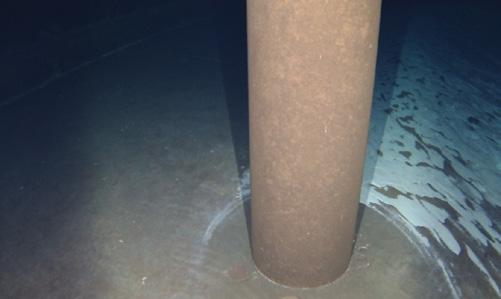

During the reporting period, the Dams and Treatment team completed the report to improve their understanding of dam safety and how this affects the monitoring, operations and management of Rous dams.
Investigations and reports focused on the seismicity, geology, and geotechnical aspects of the Emigrant Creek Dam wall.
The report primarily considered the impact of earthquakes, big and small, on the dams. The report checked the effects of seismic activity at a given location. From the assessment it was concluded that no earthquake below magnitude Mw5 would have any effect on the dams’ structure. The largest event recorded within 100 kilometres of Emigrant Creek Dam was a Local magnitude ML3.3 in 1976 on the Gold Coast, approximately 97 kilometres northwest of the site. The closest event recorded to Emigrant Creek Dam was the magnitude MD2.0 earthquake in 1979 near Byron Bay, approximately 29 kilometres northeast of the site.
Geotechnical investigations also formed part of the report, resulting in the use of sonic drilling rigs, core drilling rigs, and cone penetration testing rigs at the Emigrant Creek Dam wall to test for shear strength, permeability and unit weight, Atterberg limits, and density.



In a major milestone, the St Helena Pipeline was completed in 2023 ahead of the summer holiday season.
Rous led and funded the $27 million capital works project to replace the existing pipeline and increase its size – allowing more water to flow to coastal areas within the network.
The increased carrying capacity and vastly improved asset reliability enabling Rous to keep up with higher demand in coastal areas during peak times and to meet the needs of the region’s population and tourism growth.
Critically, the new pipeline ensures sufficient volumes of water can continue to be accessed by the community during peak times experienced on the network.

As part of the St Helena Pipeline Project, 13.2 kilometres of new pipeline has been installed from Dorroughby to Binna Burra. The pipeline width increased from 300 millimetres to 660 millimetres.
The St Helena Pipeline Project started in 2019 with construction works contracted and is part of Rous’ long-term Capital Works Program.


Statutory requirementsreporting Statutory Reporting Requirements

Unless otherwise stated, a reference herein to a ‘section’ is a reference to that section of the Local Government Act 1993 (NSW) and a reference to a ‘clause’ or ‘reg’. is a reference to that clause in the Local Government (General) Regulation 2021(NSW).
Rous’s audited financial reports
Asset reporting - section 406(2) (refer Planning and Reporting manual requirement). In accordance with the requirements of the Local Government Act 1993 and the Local Government (General) Regulation 2021, the NSW Local Government Code of Accounting Practice and Financial Reporting and the Australian Accounting Standards:
Assets to the value of $10,834 million were acquired by Rous during the reporting period, bringing total Infrastructure, Property, Plant and Equipment assets held as at 30 June 2024 to the value of $598,128 million (refer to page 33 of the audited financial reports 2023/24 (refer to link above)).
Rous’s report on the condition of public works is available on page 3 - Special Schedules 2024 of the audited financial reports 2023/24 (refer to link above).
Rates and charges written off - clause 132
Local Government (General) Regulation 2021 - cl132. The annual report must include the amount of rates and charges written off during 2023/24:
$14,116
Legal proceedings - section 428(4)(b) and clause 217(1)(a3)
An annual report must include a summary of the amounts incurred by the council during the year in relation to legal proceedings taken by or against the council (including amounts, costs and expenses paid or received by way of out of court settlements, other than those the terms of which are not to be disclosed) and a summary of the state of progress of each legal proceeding and (if it has been finalised) the result.
- Debt remains owing.
Closed - Debt recovered or payment plan agreed.
All costs of legal proceedings incurred during the period related to debt recovery for unpaid water charges. The figures contained in this table are inclusive of solicitor and court fees, and exclusive of service fees/costs and GST.
In addition to induction training, the following councillors participated in ongoing professional development:
Cr Rod Bruem Executive Certificate for elected members.
Cr Sharon Cadwallader Country Mayors Association Conference
a. Councillors were issued with a ‘Councillor Handbook’ at the beginning of their term on the governing body of Rous. No other seminars, circulars or other activities were delivered as part of the ongoing professional development program.
The following fees and expenses were incurred by councillors in accordance with the ‘Payment of Expenses and Provision of Facilities for Chairperson and Councillors’ policy in-force at the time:
Councillor attendance at conferences and seminars (includes airfares, registrations, meals and accommodation). cl217(1)(a1)(iii)
Provision of induction training of councillors and supplementary induction training of skill development for councillors.
Other training of councillors and provision of skill development for councillors.
Interstate visits undertaken during the year by councillors while representing the council, including the cost of transport, the cost of accommodation and other out-ofpocket travelling expenses.
Overseas visits undertaken during the year by councillors while representing the council, including the cost of transport, the cost of accommodation and other out-ofpocket travelling expenses.
cl217(1)(a1)(iiia)
cl217(1)(a1)(iv)
cl217(1)(a1)(v)
cl217(1)(a1)(vi)
Expenses of any spouse, partner (whether of the same or the opposite sex) or other person who accompanied a councillor in the performance of his or her civic functions, being expenses payable in accordance with the Guidelines for the Payment of Expenses and the Provision of Facilities for Mayors and Councillors for Local Councils in NSW prepared by the Director-General from time to time.
Expenses involved in the provision of care for a child of, or an immediate family member of, a councillor, to allow the councillor to undertake his other civic functions.
cl217(1)(a1)(vii) $ 0
cl217(1)(a1)(viii) $ 446 Total $ 8,274
allocation $ 39,700
During 2023/24, no overseas visits were made by councillors, Rous staff or other persons while representing Rous.
217(1)(b)(i-v)
Rous is required to appoint and employ a person under a performance-based contract to be its general manager. The General Manager is the only senior staff person employed by Council. The total amount payable to the General Manager during the reporting period was:
Total value of the salary component of the package. $ 279,200
Total amount of any bonus payments, performance payments, or other payments made to the general manager that do not form part of the salary component of the general manager. $ 0
Total amount payable by council by way of the employer’s contribution or salary sacrifice to any superannuation scheme to which the general manager may be a contributor. $ 30,712
Total value of any non-cash benefits for which the general manager may elect under the package. $ 5,854
Total amount payable by Council by way of fringe benefits tax for any such non-cash benefits. $ 5,723
Total $ 321,489
An annual report must contain a statement detailing the action taken by Rous in relation to any issue raised by the Anti-slavery Commissioner during the reporting year concerning the operations of the council and identified by the Commissioner as being a significant issue:
The NSW Anti-Slavery Commissioner has raised no direct issues with Rous for this reporting period.
An annual report must contain a statement of steps taken to ensure that goods and services procured by and for Rous during the reporting year were not the product of modern slavery within the meaning of the Modern Slavery Act 2018:
In accordance with the Modern Slavery Act 2018, we are committed to ensuring that goods and services procured are not associated with modern slavery. During the reporting year, Rous took the following steps:
1. Gap Analysis: Conducted to identify potential modern slavery risks and areas for improvement.
2. Ministerial Insights: Utilised guidance from the NSW Anti-Slavery Commissioner to inform practical measures and reasonable steps.
3. Risk Mitigation: Implemented measures such as supplier due diligence and ongoing monitoring to mitigate risks.
An annual report must provide details (names, nature, amounts) of contracts awarded for amounts exceeding $150,000.
An annual report must include details or a summary of resolutions made during that year under section 67 of the Local Government Act 1993 concerning private works carried out on private land, and details or a summary of such work if the cost of the work has been fully or partly subsidised by the council, together with a statement of the total amount by which the council has subsidised any such work during that year.
Rous did not undertake private works within the meaning of section 67 of the Local Government Act 1993 during the reporting period.
Performing paid work - Reg. 217(1)(d)(i)-(iv)
An annual report must include a summary of the Statement of total number of persons who performed paid work.
Persons engaged by the council, under a contract or other arrangement with the person’s employer, wholly or principally for the labour of the person.
Persons supplied to the council, under a contract or other arrangement with the person’s employer, as an apprentice or trainee.
1
0
Financial Assistance Contributions - section 356 and clause 217(1)(a5)
An annual report must include details of the total amount contributed or otherwise granted under section 356 of the Local Government Act 1993 to financially assist others.
employment
Management Plan - section 428(4)(b) and clause 217(1)(a9)
An annual report must include a statement of activities undertaken by a council during the year to implement its equal opportunity management plan.
Rous County Council’s Equal Employment Opportunity (EEO) Plan details our commitment to deliver equal opportunities through the Reconciliation Action Plan, the Disability Inclusion Action Plan and other measures, to ensure a workforce that is representative of the demographics of the community.
External bodies (delegated by council) - section 428(4) (b) and clause 217(1)(a6)
An annual report must include a statement of all external bodies that during that year exercised functions delegated by the council.
Rous has not delegated any of its functions to external bodies.
External bodies (controlled by council) - section 428(4) (b) and clause 217(1)(a7)
An annual report must include a statement of all external bodies that during that year exercised functions delegated by the council.
Rous does not hold a controlling interest in any companies.
External bodies (participated in by council) - section 428(4)(b) and clause 217(1)(a8)
An annual report must include a statement of all corporations, partnerships, trusts, joint ventures, syndicates or other bodies (whether or not incorporated) in which the council participated during the year.
Statewide Mutual – A self-insurance pool covering public liability and professional indemnity insurance as well as providing risk management advice.
StateCover – A self insurance pool providing cover for workers’ compensation insurance as well as providing advice on work health and safety matters.
This plan is currently under review and a new plan is to be developed in 2025/26.
* References in this section to the ‘Act’ is a reference to the Government Information (Public Access) Act 2009. Following is a copy of Rous’s Government Information (Public Access) Act 2009 (‘GIPA’) annual report to the NSW Ombudsman’s office:
Agency name: Rous County Council
Reporting period: 1 July 2023 – 30 June 2024
Clause 8a: Details of the review carried out by the agency under section 7 (3) of the Act during the reporting year and the details of any information made publicly available by the agency as a result of the review:
Reviews carried out by agency Information made publicly available by the agency 8(a)
The open access information and proactively released information made available during the relevant reporting period on Rous’s website was reviewed. The following are examples of new information of public interest that were proactively released:
+ Council agenda and minutes + Disclosure of Interest Return – Councillors 2020-2021, 2021-2022 and 2022-2023 + Disclosure of Interest Return Designated Persons 2020-2021, 2021-2022 and 2022-2023 + Media releases + Updated policies, disclosure log and contract registers + Data Breach Plan + Water restriction information + Update Land Registry + Rous Statement of Commitment + Retail Water Customer Account Assistance policy public exhibition + Northern Rivers Watershed Initiative Discussion Paper + EOI Sale of Gallans Road assets + Annual Summary of Drinking Water Quality 2022-2023 + Future Water Project update and factsheets + IP&R Framework public exhibition + Annual Report + Annual Financial and Audit reports + Presentation of annual financial statements public exhibition + Audit Risk and Improvement Committee Charter + Statement of Revenue policy public exhibition + Glossary of water terms + Update Potable Water Carter listing + RAPAG Terms of Reference 2023 + Wilsons River Reach Plan 2023 + Certificate of Compliance request form (Section 307) + Update constituent council rainwater tank guidelines + Weed fact sheets + Weekly pesticide notification (when spraying done) + Pending and awarded Tenders + Avdata prepaid key customer portal handout (Water Filling Stations) + Instrument of delegation and designation to Council staff + Rocky Creek Dam – Annual dams safety report 2023 + Emigrant Creek Dam – Annual dams safety report 2023 + Update Sustainable Water Partner Program 2023 fact sheet
Clause 8b: The total number of access applications received by the agency during the reporting year (including withdrawn applications but not including invalid applications).
Total number of applications received
8(b) 1
Clause 8c: The total number of access applications received by the agency during the reporting year that the agency refused either wholly or partly, because the application was for the disclosure of information referred to in Schedule 1 to the Act (information for which there is conclusive presumption of overriding public interest against disclosure).
Table A: Number of applications by type of applicant and outcome.
Table B: Number of applications by type of application and outcome.
Table C: Invalid applications.
Reason
Application does not comply with formal requirements (section 41 of the Act). 1
Application is for excluded information of the agency (section 43 of the Act). 0
Application contravenes restraint order (section 110 of the Act). 0
Total number of invalid applications received. 1
Invalid applications that subsequently became valid applications. 1
Table D: Conclusive presumption of overriding public interest against disclosure: matters listed in Schedule 1 of the Act.
Table E: Other public interest considerations against disclosure: matters listed in table to section 14 of the Act.
Table F: Timeliness.
Decided within the statutory timeframe (20 days plus extensions). 1
Decided after 35 days (by agreement with applicant).
Not decided within time (deemed refusal).
Table G: Number of applications reviewed under Part 5 of the Act (by type of review and outcome).
following recommendation under section 93 of the Act.
Table H: Applications for review under Part 5 of the Act (by type of applicant).
by access applicants.
Applications by persons to whom information the subject of access relates (see section 54 of the Act).
Table I: Applications transferred to other agencies.
Constituent councils are the relevant planning authority for the local government areas and as such, Rous has no function in reporting on planning requirements.
Rous revised its Privacy Policy and Privacy Management Plan in October and November 2023, respectively, to incorporate provisions relating to the new Mandatory Notification of Data Breach Scheme.
Following is a summary of Rous’s Public Interest Disclosures (PID) annual report to the NSW Ombudsman.
Reporting period: 1 July 2023 - 30 June 2024
* Rous has in place an internal reporting policy: Public Interest Disclosures.
* The General Manager has taken action to meet staff awareness obligations by implementing a range of measures such as: Incorporating training into Council’s Employee Induction Program; raising awareness of PIDs, including outcomes of recent investigations by the ICAC, in the internal staff newsletter; making available public Interest Disclosure (PID) Information within the electronic document management system; and ensuring all Council worksites display the NSW Ombudsman-supplied posters with details of who a PID may be made to.

The financial performance of Rous is aligned with its continued focus on long-term financial sustainability. Quarterly budget review statements are utilised to monitor financial performance and make adjustments to account for the changing conditions and requirements identified throughout the year. The LongTerm Financial Plan is reviewed annually to ensure short-term needs are considered against long-term sustainability. As a result, Rous remains in a strong financial position with cash and investments at satisfactory levels to ensure that all current liabilities can be met when due.
The financial position for the 2023/24 financial year remains strong despite a net deficit result of -$0.15 million (2023: $4.2 million), including depreciation expense of $8.4 million (2023: $8.0 million).
Overall income has increased by $2.3 million to $38.4 million compared to the previous year (2023: $36.0 million). Most of the increase can be attributed to additional bulk water charges and interest on investments when compared to the previous year.
Council continues to align its ‘Investment’ policy with NSW TCorp investment guidelines. Over the past 12 months, Council’s return on investments was 4.35%. The result achieved is consistent with Council’s strong investment performance despite difficult market conditions. Council’s investment performance was exceeded the benchmark, being the bank bill swap rate (BBSW), which had an annual result of 3.30%.
Council’s overall financial position improved during the past 12 months with total equity increasing by $28.2 million.
Rous owns a commercial property in the Lismore CBD, which was previously leased to a business entity to obtain a commercial return, however has been vacant since the February / March 2022 flood events. The property portfolio is regularly reviewed to ensure returns are optimised and make a positive contribution to revenue overall.
In addition, Rous is the head lessee of the Rous County Council Administration Centre, 218-232 Molesworth Street, which accommodates a number of staff, as well as providing commercial leasing revenue from non-Rous occupied space.

of financial report for the year ended 30 June 2024

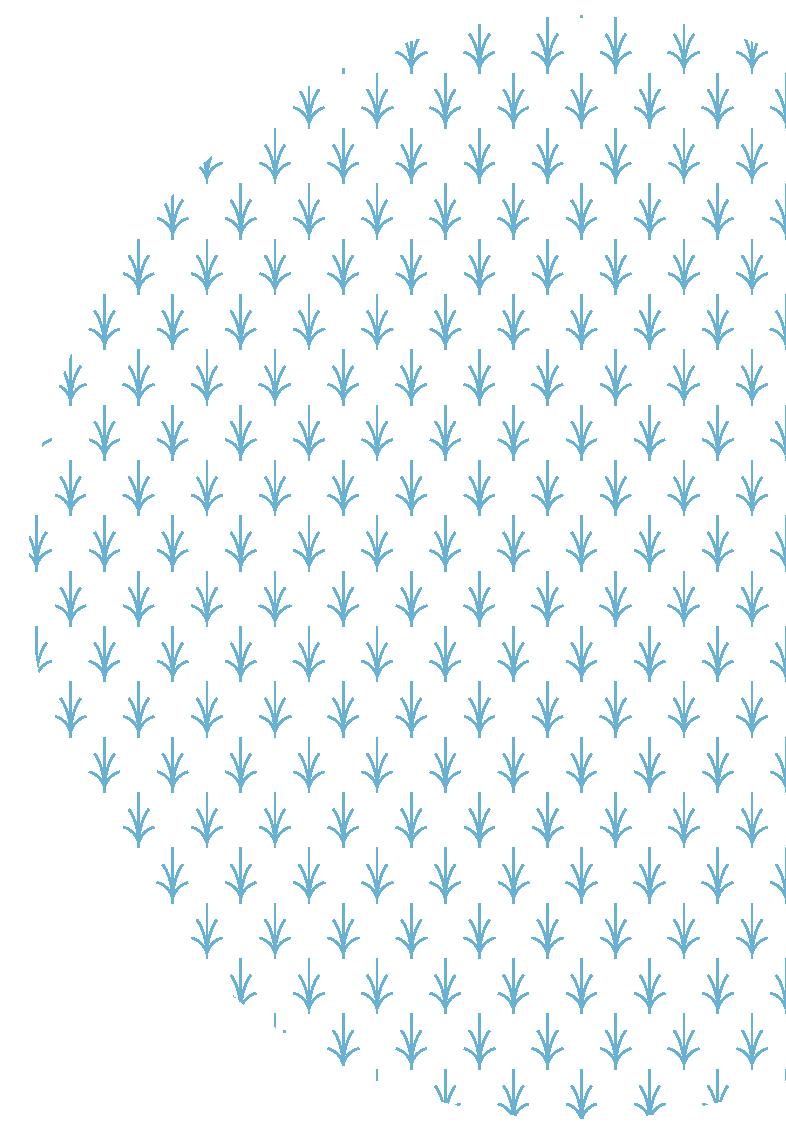


The Local Government Act mandates that the outgoing elected body of Council must prepare a final endof-term report, detailing achievements in implementing the strategic direction of the Business Activity Strategic Plan (BASP) over the term of the Council. This report, known as the State of the Region Report, is to be presented to and endorsed at the second meeting of a newly elected council.
The preparation of a State of the Region Report is a legislated requirement and part of the Integrated Planning and Reporting framework. It serves as a progress report prepared at the end of the term of the outgoing elected council.
The report provides the incoming Council with information on the progress of the implementation and effectiveness of the BASP during the previous council’s term in office. This assists the newly elected council in reviewing and refining the BASP.
The BASP sets out Rous’s strategic objectives and the approach to achieving those objectives. It was developed in consultation with Rous’s constituent councils and considers their Community Strategic Plans to ensure Rous’s goals match those of the regional community.
The diagram below details the percentage of activities undertaken by Rous during the 2022-24 term in pursuit of each of the BASP themes.

This section of the report details the percentage of actions within each BASP theme that were completed, started, delayed, or unfinished this term. Please note that the delivery of certain planned activities was impacted by the floods in 2022.
1.1 A healthy environment.
1.2 Responding and adapting to climate change.
1.3 Water security, quality and sustainable consumption.
1.4 A sustainable Council.

A snapshot of activities undertaken during the term:
• Developed a procurement strategy and a completed revision of the existing procurement policy.
• Completed the Coastal Zone Management Plan scoping study.
• Completed the Purified Recycled Water and Desalination options reports.
• Commenced the development of the Enterprise Risk Management framework.
• Rolled out smart meters and backflow prevention devices across the Rous water network along with associated MyRous App.
• Completed the dam break and consequence category assessment and surveillance investigations for both Rocky Creek Dam and Emigrant Creek Dam as part of the ongoing activities of the Dam Safety Management Plan.
• Delivered the ‘Mindful Water Habits Start now’ social media campaign focusing on highlighting the limited supply of water and sustainable water practices.
• Continued work on the 10 year Fosters Spur, bush regeneration project. 61%
• Educated up to 1200 school children from nine different local schools on water literacy and water sustainable behaviours.
• Developed the Alstonville water supply scheme and reinstated the Woodburn groundwater scheme.
• Planned and undertook restoration work to revegetate and control weeds in the Upper Emigrant Creek catchment as part of the River Reach Program.
• Mitigated weed biosecurity threats after the 2022 flood.
• Delivered education and a public awareness campaign to prevent the highly invasive weed, Miconia Calvescens in NSW.
• Commissioned a natural resource management discussion paper.
• Eradicated scattered infestations of Frogbit (Limnobium laevigatum) near Kingscliff, Dorroughby and Swan Bay.

2.1 Strong and mutually respectful relationships with our constituent councils.
2.2 People across our region understand the work that we do.
2.3 Our working relationships with political, regulatory and industry stakeholders are effective and achieve results.
A snapshot of activities undertaken during the term:
• Established face-to-face networking events with each of the constituent Councils communications and customer service teams.
• Established close partnerships with our constituent councils, regularly providing information relating to water, weed biosecurity, and rural flood mitigation to the community through their newsletters and social media channels.
• Completed the communications and engagement, branding and marketing strategies.
• Participated in meetings and forums for the water quality network, recycled water regulator and DWMS review and risk workshops and site visits.
• Coordinated and participated in the Regional Water Supply Liaison Committee.
• Coordinated the Cudgerie Gully planting day with the Casino Food Co-op partnership.
• Provided support to the Department of Primary Industries with biosecurity emergency response to eradicate an outbreak of white spot disease in prawn
farms in the Clarence River and varroa mite near Taree.
• Secured a $40K grant from the NSW Coast and Estuary management Grant program to undertake additional works on the eastern bank of the river at Coraki.
• Secured a $6.9M grant for Bungawalbyn Levee Remediation work.
• Identifed businesses to participate in the Sustainable Water Partnership Program.
• Participated in the Northern Rivers Joint Organisation.
• Reviewed and updated Rous Reconciliation Action Plan.
• Staff visited Myall Creek to commemorate the Myall Creek Massacre, near Bingara (NSW).
• Contributed to the Weeds and Pest Advisory Committees as part of our flood and water policy contribution.
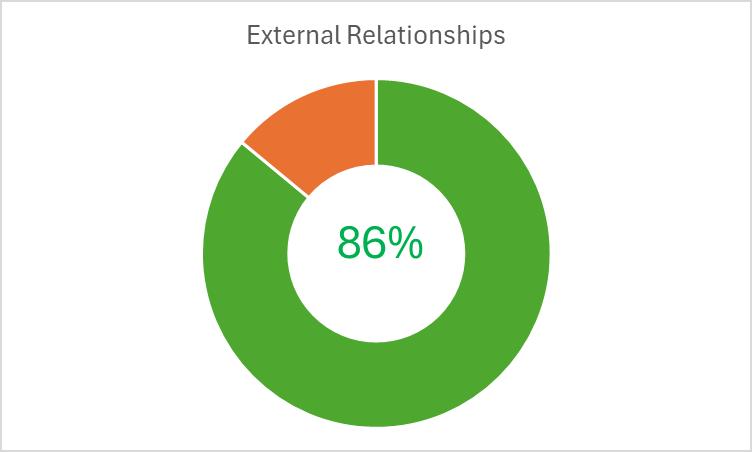
3.1 Our future workforce requirements are confirmed.

3.2 Innovative solutions are applied to addressing skills gaps.
3.3 Leadership is facilitated across the organisation.
3.4 We are recognised as an employer of choice.
A snapshot of activities undertaken during the term:
• Invested in Health, Safety and Environment business outcomes through increased staff resourcing.
• Improved business processes for reporting safety incidents.
• Digitised Safe Work Method Statements and Safe Work Instructions to make them more accessible and easier for employees to use.
• Expanded rollout of BeSafe, Vault Check and Vault Notify Apps
• Implemented ELMO Human Resources Information System for recruitment, onboarding performance and organisational mandatory training now all managed through the HRIS.
• Delivered ongoing education and awareness at all levels of the organisation with SafeWork NSW to discuss the latest changes to workplace health and safety legislation.
• Successfully implemented an assistance dog in the workplace to provide support for a worker’s health and wellbeing.
• Hosted the 2024 International Women’s Day Event with guest speaker Rabia Siddique with staff attending from the constituent councils.
• Implemented a staff intranet, ensuring that staff are kept up to date and have access to essential information.
Recipient of the following Awards:
• Water Industry Operators Association of Australia (WIOAA), Ixom Best Tasting Tap Water,
• Excellence in Environment Award, LGNSW, Fosters Spur regeneration project,
• Women in LG (Regional), Employment Diversity Award
• Women in LG (Rural/Regional), Champion of Change Award
Finalists in the following Awards:
• LG Excellence Awards, Environmental Leadership – for the Fosters Spur regeneration project,
• LG Excellence Awards – Assets and Infrastructure, for the St Helena 600 pipeline project.
• Rous Leadership Team focused on improving internal communications and implementing strategies for more opportunities for two-way engagement between Leadership and staff

4.1 Be recognised for leadership in what we do.
4.2 Effective use of technology supports the achievement of organisational objectives.

4.3 We embrace innovation and continually improve the way we do business.
A snapshot of activities undertaken during the term:
• Hosted the 2023 Blackwater Roundtable Discussion with stakeholders from the across NSW, discussing blackwater in coastal floodplain wetlands.
• Used advanced acoustic technologies to detect water leaks.
• Continued delivery of the Active Floodgate Management program.
• Conducted PFAS (per-and polyflouroalkyl substances) testing of the Rous water distribution network and Wilsons River.
• Installed new tubidity analysers at Nightcap Water Treatment Plant.
• Refurbished Gasworks pump station after the 2022 flood.
• Replaced the dam water pump lifting arm at Emigrant Creek Dam.
• Completed the $27M St Helena Pipeline project.
• Implemented an app-based credit card program.
• Implemented a new modern telephony system.
• Commenced the Rous Digital Transformation program – Program Novus.
• Activated the Information and Communication Technology Business Continuity Plan during the 2022 flood.
• Secured approval of a development application for the Gallans Road, Ballina site.
• Attended Australia’s leading water conference OzWater’24, providing staff with the opportunity to learn from the experiences of others and stay at the forefront of new approaches in planning and managing water resources and systems.
• Purchased an underwater drone to allow inspections of resevoirs to be undertaken inhouse, eliminate work health and safety risks and reliance on the availability of trained divers.


